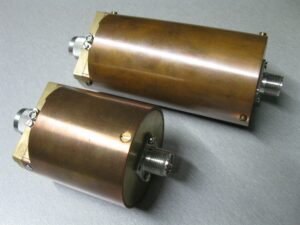Start - Research and development works - Program OPUS-24
A project under the OPUS-24 programme

The root mean square (RMS) of the voltage is one of the most often measured parameters of alternate current (AC) voltage. The RMS voltage measuring instruments have to be calibrated periodically, and the calibration result has to be traceable to a primary standard. Each developed country has its own primary standard. In principle, the most accurate AC voltage standards are quantum voltage standards based on Josephson effect. Unfortunately, their actual accuracy in radio frequency range is insufficient and instead of them in high frequency range (between 0,1 MHz to approximately 100 MHz), thermal voltage converters are used. Nowadays, the most precise method of reproducing the AC voltage in high frequency range is the calorimetric thermal voltage converter (CTVC), designed and manufactured at National Research Council, Canada (NRC). The CTVC is composed of a short coaxial waveguide, heater in the form of a microwave resistor with very small residual parameters and a sensitive multijunction thermocouple. The principle of operation of the CTVC is based upon the Joule-Lenz heating, which causes an increase of temperature in the resistor (the heater), while AC or DC signal is applied. Firstly unknown AC voltage is applied until steady state of the resistor (heater) temperature is achieved. This temperature is being measured by a thermocouple connected to a high-precision nanovoltmeter. Then adjustable well-known value of the DC voltage is applied to the CTVC to get the same temperature (an output voltage) as for previously applied AC voltage. This procedure is called the voltage AC-DC transfer. Because of the specific CTVC geometry, it is possible to develop a mathematical model to calculate the value of the unknown AC voltage in terms of the known DC voltage, both sequentially applied to the CTVC heater. The CTVC is actually the most precise voltage standard in the word in the frequency range of 1 MHz to 100 MHz. The recent progress in development of materials and technology opened up the new viabilities of a manufacturing complex structures with improved performance. Among them it is possible to manufacture a multilayer compositions containing materials responsible for different properties. As an example, combination of Teflon with deposited thin layers of copper, silver and gold forms a structure featuring high electrical conductance, high thermal resistivity, low sensitivity to environmental conditions and a high durability. This kind of material combination technology will be investigated in terms of their applicability in waveguides. Such waveguides are important parts of wideband thermal AC voltage standards. Because the AC-DC transfer difference of the CTVC is primarily caused by skin-effect and characteristic impedance mismatch between a waveguide and a resistor (heater), we make a hypothesis that the novel metal-organic waveguide can significantly improve the performance of the CTVC used as a primary AC voltage standard and thus complement the low bandwidth of the Quantum AC Voltage Standard. The goal of the project is to design of a new metal-organic waveguide and measure its performance under different conditions. Then, the waveguide will be used in a precision voltage standard to define its usefulness and the improvement of the standard itself.










